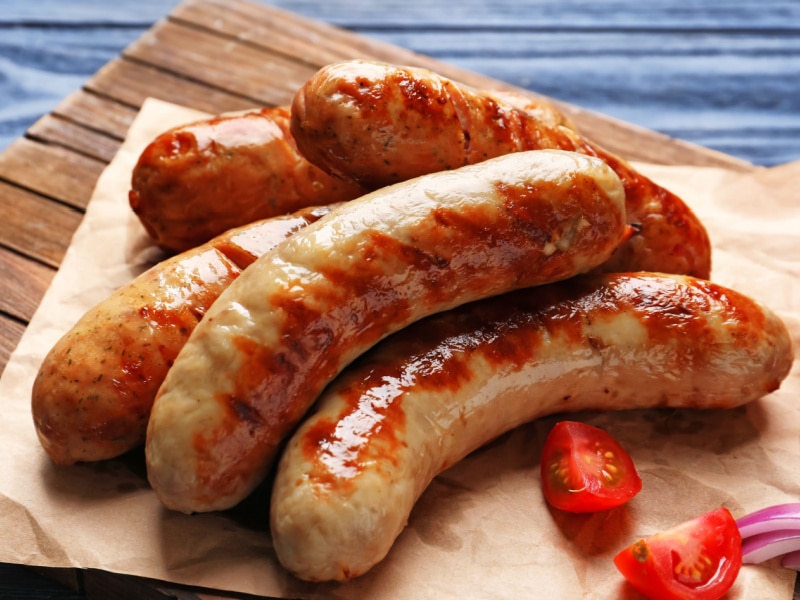Sausage and hot dogs are similar, but they have subtle and distinct differences. Both are encased meats.
But sausage refers to a broader category of seasoned ground meat in various casings. Hot dogs are a specific type of fully cooked and cured sausages.

So, what’s the real deal behind these meaty treats? Are hot dogs just sausages in disguise? Or is there more to this culinary mystery?
Let’s distinguish between these two special food items. Sit back, grab a bun, and explore the differences!
Hot Dog vs. Sausage (What’s the Difference?)
Hot dogs and sausages, though seemingly similar, have distinct differences.
Sausages are an umbrella term for ground meat, fat, water, and seasonings stuffed into casings. They come in various forms: raw, fully cooked, short, long, or linked.
Hot dogs fall under the sausage category but are a more specific type. They’re made from meat trimmings, spices, salt, and sometimes fillers and preservatives. Then, they’re emulsified into a paste before being encased.
Uniform in thickness, they range from tiny cocktail wieners to foot-long delights. While all hot dogs are sausages, not all sausages are hot dogs.

What Are Sausages?
Sausage is made from ground, minced, or chopped meat combined with fat, water, and seasonings. The types of meat used can vary. They include chicken, beef, pork, and even seafood.
The mixture is then encased with natural casings made from animal intestines. It can also be made from artificial ones made from edible collagen or cellulose.
Sausages can be prepared in many ways: raw, cured, cooked, smoked, or combined. Various sausage styles, fresh to cured and smoked, each bring a distinct flavor profile.
Cooking methods for sausages vary. They include pan-frying, roasting, boiling, and grilling, allowing for many textures and tastes.
Globally, sausages have a cherished place in many cuisines. For instance, Germany is famous for its Frankfurters. Spain and Mexico are known for spicy Chorizo. Korea is credited for its Sundae blood sausage. And Poland is famous for Kiełbasa.
History of Sausage
The history of sausage goes back to ancient times, specifically around the 9th century BC.
Interestingly, sausages were a hit among the Greeks and Romans. The Greeks even dedicated a play to it, called “The Orya” or “The Sausage,” signifying its popularity.
Sausages likely emerged as a practical solution for preserving meat. Meat scraps, offal, and animal blood were encased in animal intestines. This prolonged the meat’s lifespan.
The term “sausage” is believed to have its roots in the Latin word “salsus,” meaning “salted.” This makes sense, as salt was a primary preservative used in sausage-making.
The Romans, not to be outdone by the Greeks, embraced sausages. They experimented with various flavors and types of meat. This created an assortment of links.
One noteworthy Roman contribution is the “lucanica.” It originated in the ancient region of Lucania. It’s a spicy sausage made from beef or pork.

Types of Sausage
Sausages can be divided according to their preparation: raw, cured, cooked, and smoked.
Raw Sausages
They’re made from fresh ground meat mixed with seasonings and then encased. They’re perfect for grilling or frying. Raw sausages are unprocessed and need to be cooked before consumption.
Cured Sausages
Cured sausages undergo a preservation process using curing salt. It’s a blend of salt and nitrates. This not only extends the shelf life by slowing down spoilage. But it also maintains the vibrant red color of the meat.
Cooked Sausages
As the name suggests, cooked sausages are pre-cooked during preparation. They’re often simmered in salted water or broth. But they can also be cooked using other methods. They’re convenient and quick to prepare. So they’re great for busy nights when you need a tasty meal with little fuss.
Smoked sausages are treated with smoke derived from firewood. This method imparts a deep, smoky flavor and aids in preservation.

What Are Hot Dogs?
Hot dogs are a sausage from finely ground meat mixed with fat, water, and seasonings. This mixture is then cooked, often smoked, and sold with or without the casing.
The term “hot dog” is synonymous with the Americanized version of the German sausage. It draws inspiration from the German frankfurter and wiener.
“Hot dog” can also refer to the sausage itself or the popular snack in a bun.
Across the United States, you’ll find an array of regional hot dogs, with each region having its twist. We’ll discuss this further in a bit.
But first, a history.
History of the Hot Dog
Frankfurt-am-Main, a city in Germany, claims to have created the hot dog in 1487, leading to the term “frankfurter.”
However, some attribute its creation to a butcher in Coburg, Germany. Vienna (Wien in German), Austria also stakes a claim, resulting in the name “wiener.”
Regardless of which city it hails from, it’s agreed that the hot dog has Germanic roots. German immigrants are also credited with bringing hot dogs to the United States. They arrived in New York, around the 1860s.
Why Are They Called Hot Dogs?
Johann Georghehner, a 17th-century butcher from Coburg, Germany, is a key figure in hot dog history. Legend has it that Johann traveled to Frankfurt to promote his new creation. He called it the “little dog” sausage.
Historians suggest the Dachshund dog breed could have also inspired the name. German immigrants reportedly referred to their sausages as “Dachshund sausages” or “little dogs.” This draws parallels to the small, elongated dog.
This playful nickname evolved, and “hot dog” took hold.

Common Sausage Varieties Used in Hot Dogs
Three sausage varieties are predominantly found in hot dogs: franks, wieners, and bologna sausages.
Franks
Often called frankfurters, franks owe their name to Frankfurt, Germany, where they were born. These sausages are crafted from beef cooked and smoked and available in casings or without.
Wieners
Wieners have their roots in Vienna, Austria, called “Wien” in German. These sausages consist of a blend of pork and beef cooked and smoked. Like franks, you can get them with or without casings.
Bologna Sausages
Bologna sausages, casually called “baloney,” originated in the Italian city of Bologna. They’re an adaptation of Italian mortadella and are made from pork mingled with spices. Among these spices are myrtle berries, responsible for their characteristic sharp aroma and taste.

Can You Use Sausages as Hot Dogs?
For sure! You can use a variety of sausages as hot dogs if you’re feeling creative.
Traditional hot dogs use franks, wieners, or bologna sausages, but no rule stops you from branching out.
So if you’re wondering about bratwurst vs sausage or maybe even chicken sausage, so for it!
Italian sausages can be another excellent alternative. Bake or grill them. Then, add marinara sauce, mozzarella cheese, and fresh basil for an Italian-inspired dog.
Even breakfast sausages can make their way into a hot dog bun. Think of this as a breakfast sandwich-hot dog fusion.










